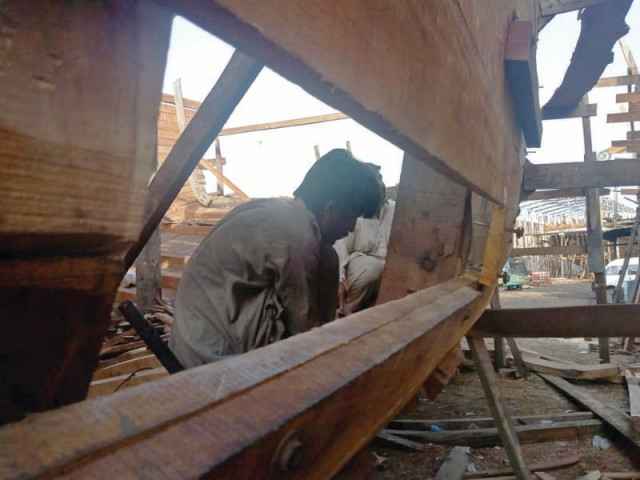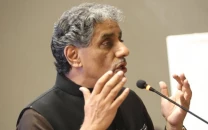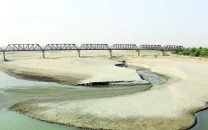In rough seas: Boat-building industry struggles to stay afloat
With fishermen switching jobs due to depleting marine life, shipwrights struggle to find work

Shipwrights struggle to make ends meet as the rising costs of building boats, depleting marine life and sea pollution has dealt severe blows to the once thriving industry. Photos: Express
The catch is sold in local markets and even exported across the world. What remains is cooked at home. For these fishermen, their most prized possession is their boats, hundreds of which are lined in jetties - some natural, others man-made - along the coastline.
Over the years, these fishermen have had to brave rough seas and the ever-depleting marine life, which is a direct result of sea pollution. But they must now prepare for their biggest challenge yet - something that threatens their very livelihood.
Fishermen marching against Kalabagh dam to reach Karachi on Oct 25
With the rising prices of wood and timber, the cost of manufacturing a boat has seen a sharp increase over the years. One alternative is to purchase the boats seized from Indian fishermen, who have been arrested for crossing into Pakistan's territorial limits. The boats are granted legal status and subsequently sold to local fishermen.
This has endangered the one industry closely aligned to fishing - boat-building. With fishermen looking for other sustainable sources of income and others preferring to buy the cheaper Indian boats, local shipwrights have been dealt the heaviest blow.
The economics
At a minimum, it takes a year to build a small boat, depending on its size. Smaller ones are ready to go out to sea in one to two years, while cargo ships may take three to four years. The average size of a fishing boat may vary between 30 and 50 feet.
Normally, a small boat would cost Rs10 million to build. But due to the rising prices of teak wood, the industry has turned to using Malanga wood that is imported from the African continent. With the depreciating value of the rupee, the price of this wood has also increased by around 30% to 35%.
Boats built in Pakistan are also exported to Dubai, Iran and other Gulf countries. Their number, too, have witnessed a significant drop as much of the goods are now supplied in containers on large ships, rendering the less-economical cargo boats useless.
'Kabuli' reconditioned engines are installed in the boats, which are imported as scrap items and then refurbished locally to meet the boat's requirements. The price of engine can vary between Rs0.5 million to Rs1 million. Older engines and boats must be repaired from time to time. Newer ones may need no repairs for up to five years. Ultimately, if a boat is properly cared for, it may last up to 30 or even 35 years.
Overall, the boat-building industry in Pakistan employs around 10,000 people - the majority of them daily-wage labourers, who make between Rs800 and Rs1,000 on average each day.
A labour of love
The art of boat-building has been passed down from generation to generation in the coastal villages of Sindh and Balochistan. Compared with other South Asian countries, boats prepared in Pakistan are stronger and more aesthetically appealing. The skill is so ingrained in the local communities that shipwrights build most boats without layouts or sketches.
The process of building a boat consists of four phases. In the first phase called 'lay', the foundational structure of the boat is laid out. This basic structure, colloquially referred to as 'pathan', is made of wooden planks laid at the bottom of the structure in a rib-like formation.

Once the inner formation is in place, the exterior structure, comprising wooden planks, is hammered together with nails, in a process colloquially referred to as 'darhi'. Subsequently, the deck of the boat is built.
In the last phase, the engine is installed in the boat and it is given decorative inscriptions and artwork tailored to the taste of the owner or in some cases, the shipwright.
Drying the wood boat takes several months. This is done to reduce the weight of the wood and it can be strengthened to withhold the force of the rough sea.
A dying venture
Haji Moosa, vice-president of the Boat Builders' Association lamented that climate change has affected the sea, much like it has affected the mountains and forests. In the absence of rains, the growth and breeding cycle of marine life.
The rains, he explained to The Express Tribune, bring mineral and food into the sea, driving the fish to move toward creeks closer to coastal areas, where they breed. With the decrease in rainfall, minerals and food resources have been depleting in the sea.
The other danger is from the industrial pollutants and urban waste released into the sea without being treated.
According to Haji Moosa, the Arabian Sea is fast running out of food and the breeding cycle of marine life is in peril, which is why fishermen have started looking for other jobs and hence the number of orders for boats has been on the decline. Those who remain must now venture into even deeper waters, sometimes inviting the risk of venturing into Indian territory and getting imprisoned across the border.
Indian fishermen remanded to jail custody
Waiting to be noticed
No government has ever paid attention to the local boat-building industry. In the absence of official recognition, attracting investment is difficult to say the least. Banks refuse to provide financial services.
Several shipwrights The Express Tribune spoke to complained about the lack of facilities at the ship-building yard in Karachi. Labourers build boats under the open sky and the engines too are refurbished out in the open. The path leading up to the yard is unpaved and there are no arrangements to clean up the place.
According to the shipwrights, all their skills have been acquired on the job, passed down from generations. No one has bothered to train them in newer techniques or equip them with the latest technology. All this has meant is that the boats they build, though sturdy, fail to meet international standards.
Published in The Express Tribune, October 22nd, 2018.



















COMMENTS
Comments are moderated and generally will be posted if they are on-topic and not abusive.
For more information, please see our Comments FAQ